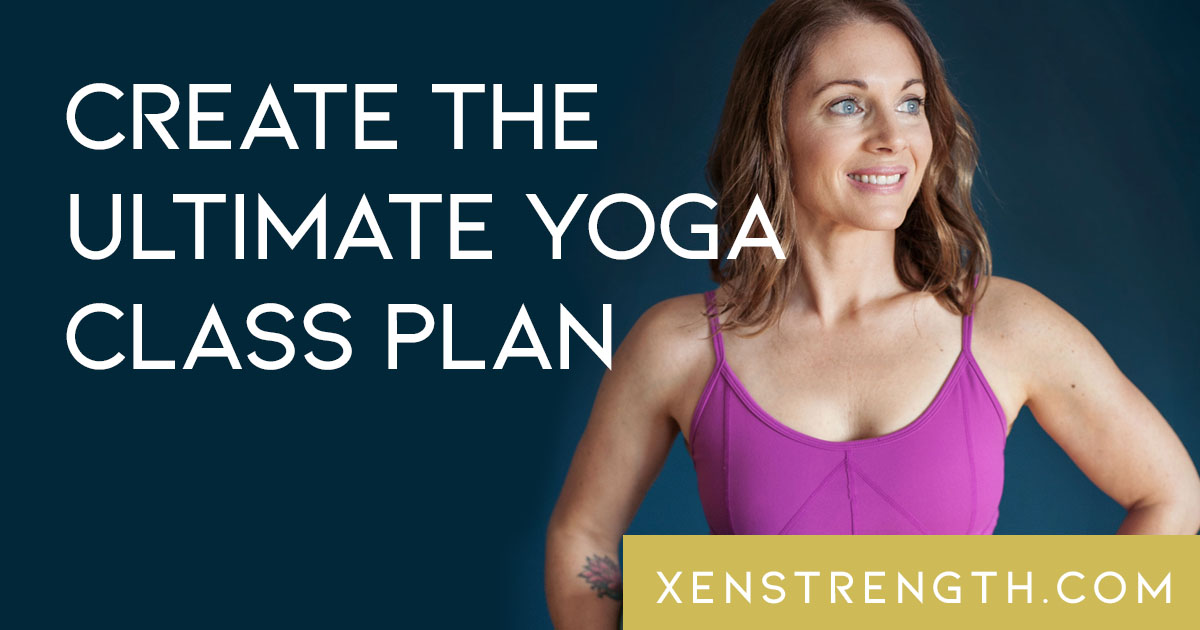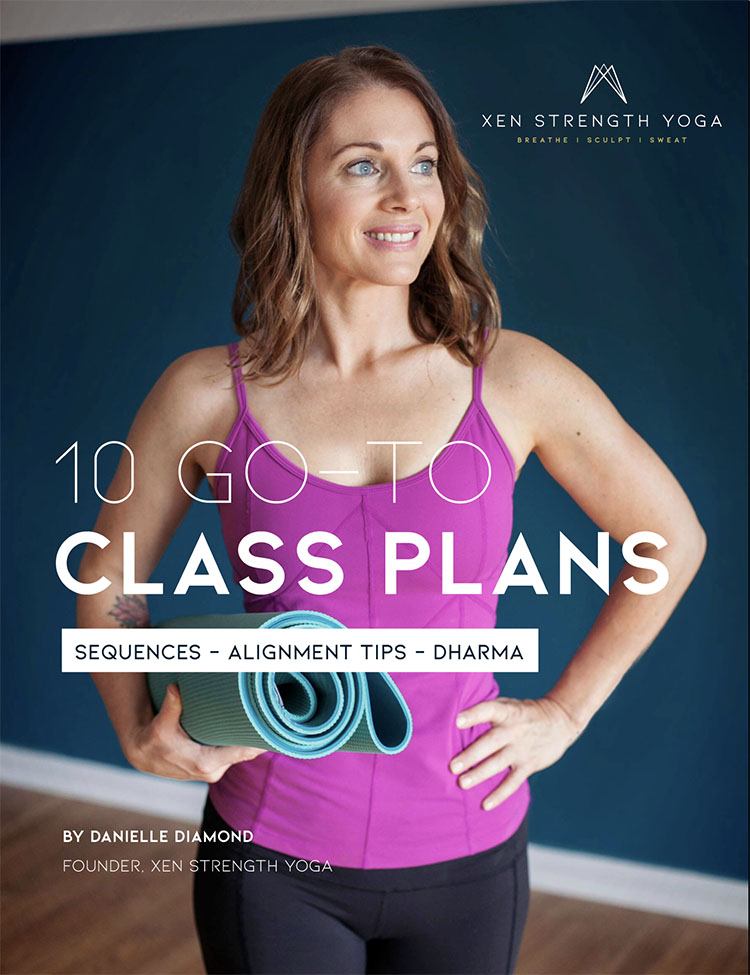
I absolutely love creating new sequences and playlists, and researching dharma topics and new alignment instructions – but when I first started out I had no idea how to do it on my own.
It takes a ton of time and dedication to truly offer your students an experience instead of the same old yoga class that everyone else is teaching, but it’s not always easy to come up with original ideas for sequences, playlists, dharma talks and more!
I used to sit there and wish someone would do it for me, like a little yogi in a bottle would pop out with the perfect plan, but it never happened.
At least I figured out a way to spend the time I had wisely- making sure each class had certain elements in it that would not only create an educational experience but also be a ton of fun.
And I’m happy to share a few quick tips with you to make your yoga class planning easier, so it doesn’t take you more time to plan it than it does to teach it!
Figure out what type of yoga class you’re going to be known for teaching
I’ve had some of the same students coming to my classes for the last 15 years because they know exactly what they’re going to get and love the consistency of what I offer: a sweaty, challenging vinyasa flow sequenced around a theme of opening a certain body part or a peak pose, bookended with an inspiring dharma talk and closing meditation- all to a fun soundtrack that can include anything from Krishna Das to Das Efx….. I was a producer at MTV pre-yoga career, so music is a huge part of everything I do.
Will your class only be focused on the physical? Will you teach pranayama and meditation? Will you talk about the Yamas and Niyamas? Will you play music, and if so what kind?
All of these answers will contribute to the “experience” you’ll create for your students and if you create one they like, then they’ll keep coming back!
The most important thing to remember is that you can’t please everyone, and if you try to please everyone you’ll wind up pleasing no one- so remember to do YOU, which brings me to my next tip.
Find your own voice as a yoga teacher
I remember when I first started teaching, I pretty much copied everything my mentor did. I used the same type of sequencing, the same music, I read from the same sutra book, and I think I even started using her mannerisms, which I’m sure freaked out students who also took her classes.
After a month or so I realized that I was totally playing it safe trying to copy her and that I needed to develop my own style and attract my own tribe.
It’s okay to share something someone reads or borrow a transition here and there, but make sure you find your own voice, your own instruction of the poses, your own style of music and your own translation of the Yamas and the Niyamas. Don’t be a copy-cat.
Look everywhere for Dharma inspiration – everywhere!
I was once at a John Mayer concert and for the first time wasn’t claustrophobic in a sea full of people on the stadium floor. I realized I was using my pranayama to stay calm and meditating on the idea that I was safe for the first 20 minutes. A few weeks later I brought that into my teaching a class on the great lawn at Bryant Park for Yoga Journal- with 750 yogis mat to
I could tell people were feeling a bit like sardines so I shared my experience and it made for a great dharma talk about non-attachment. When you let your students see you as a student, always learning and sharing how you live your yoga, it inspires them to do the same.
Know how to design a yoga sequence that can be modified for anyone who comes.
Unless you’re teaching a specified level, you’ll most likely get anyone from a fellow teacher to someone who has never stepped foot on a mat in the same class at the same time. You need to know how to teach to both of them.
Creating a sequence with a peak pose that requires all advanced poses to get into is no bueno for an open level class. Make sure that you pick poses that can be modified either by putting a knee down or using a prop, etc. You want to make people feel welcome, and by giving modifications and talking about how you need to start some you’ll make everyone feel comfortable.
When creating your yoga sequencing lesson plans know of creating a safe and effective yoga flow
Every class should have a centering, warm up, core sequence, and relaxation.
Centering can be anywhere from 5-10 minutes, depending on how long the class is. You can include a few rounds of chanting OM, a dharma talk, pranayama, a short meditation or a reading from your favorite yoga book or even an inspiring poem.
The warm-up should do just that- warm them up for whatever you’ve got planned. I like to coordinate the opening in the body during the warm up with what we’ll be focusing on the class, whether it’s hips, shoulders, core, etc. You can do a few rounds of sun salutations or even a yin-style hold in a few poses.
The core sequence is the bulk of the class and will vary whether you’re teaching Iyengar, Vinyasa or another style that might have a more set sequence. You’ll want to include forward bends, backbends, twists, standing poses, arm balances and inversions.
The relaxation piece should include a few reclined poses; a spinal twist or reclined bound angle with pranayama are a great way to lower the heart rate, calm the nervous and prep them for savasana. The little things you do to make your students feel special really matter here-a lavender scented neck massage, offering a bolster for under their legs or a blanket over their shoulders does the trick.
Offer unique yoga alignment and anatomy instruction
When I’m planning a class I focus a ton of energy on figuring out new ways to teach the same old thing. Warrior 1, warrior 2, reverse warrior DOES get boring after a while, but flowing through them holding a strap makes it a whole new experience.
Focusing a class on core and explaining that a 6 pack is really an 8 pack and using different tools to teach the engagement and alignment of working the core- ever move through a sun salutation with your feet on a blanket, sliding through the poses to engage your core-it’s an entirely new experience.
How to build a better yoga class sequence
The yoga teaching arena is getting more crowded every 6 months when new trainees roll out of their training. You want to make sure that your classes stand out so that you get hired to teach more, so that students keep coming back to your class, AND so that those students invite their friends to come to their favorite class in town.
Take a few hours when you have time to sit down and plan a few great “back pocket” classes that you can return to over and over again-especially in those moments that you don’t have time to plan a new class. Find new music, come up with new sequencing, inspiring dharma talks and alignment instruction.
Trust me, your students will LOVE you for it!!
Want my done for you yoga class plans?
Spend more time playing and less time planning with 10 done – for – you class plans that include sequences, playlists, anatomy, alignment, dharma and meditation instructions.


